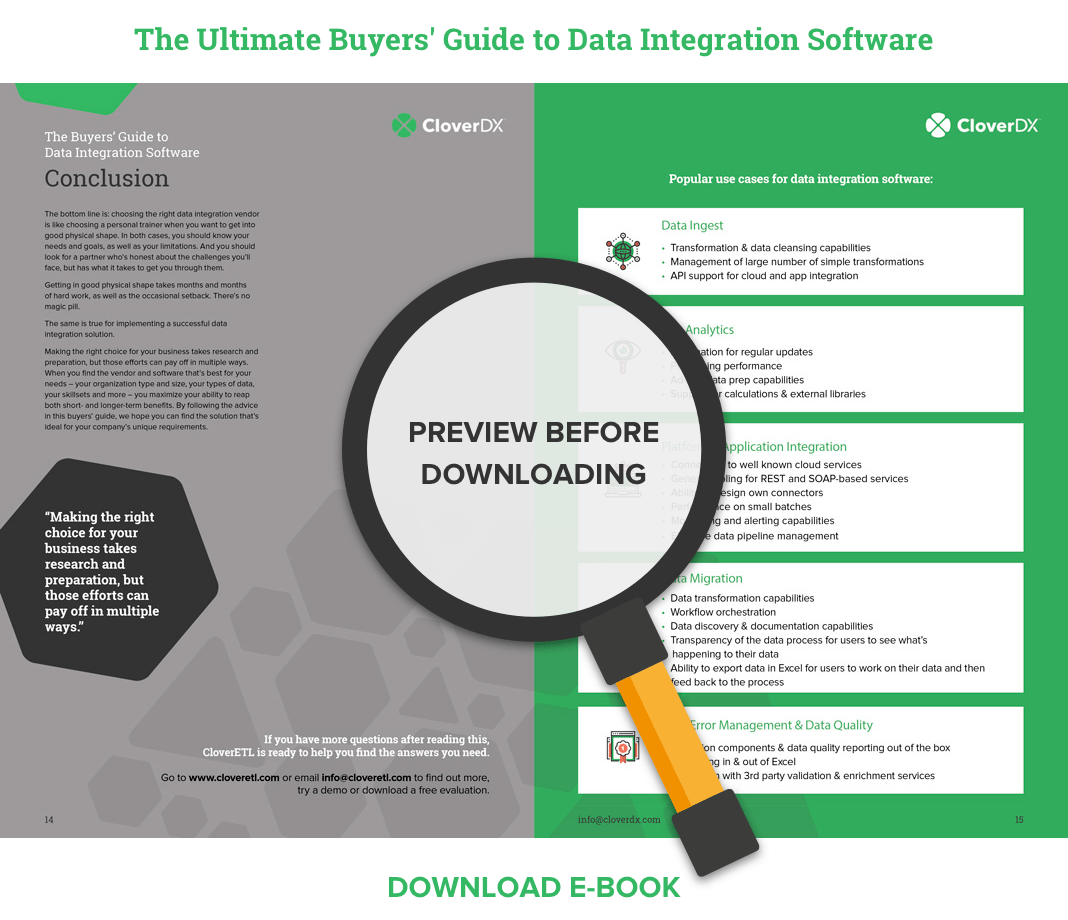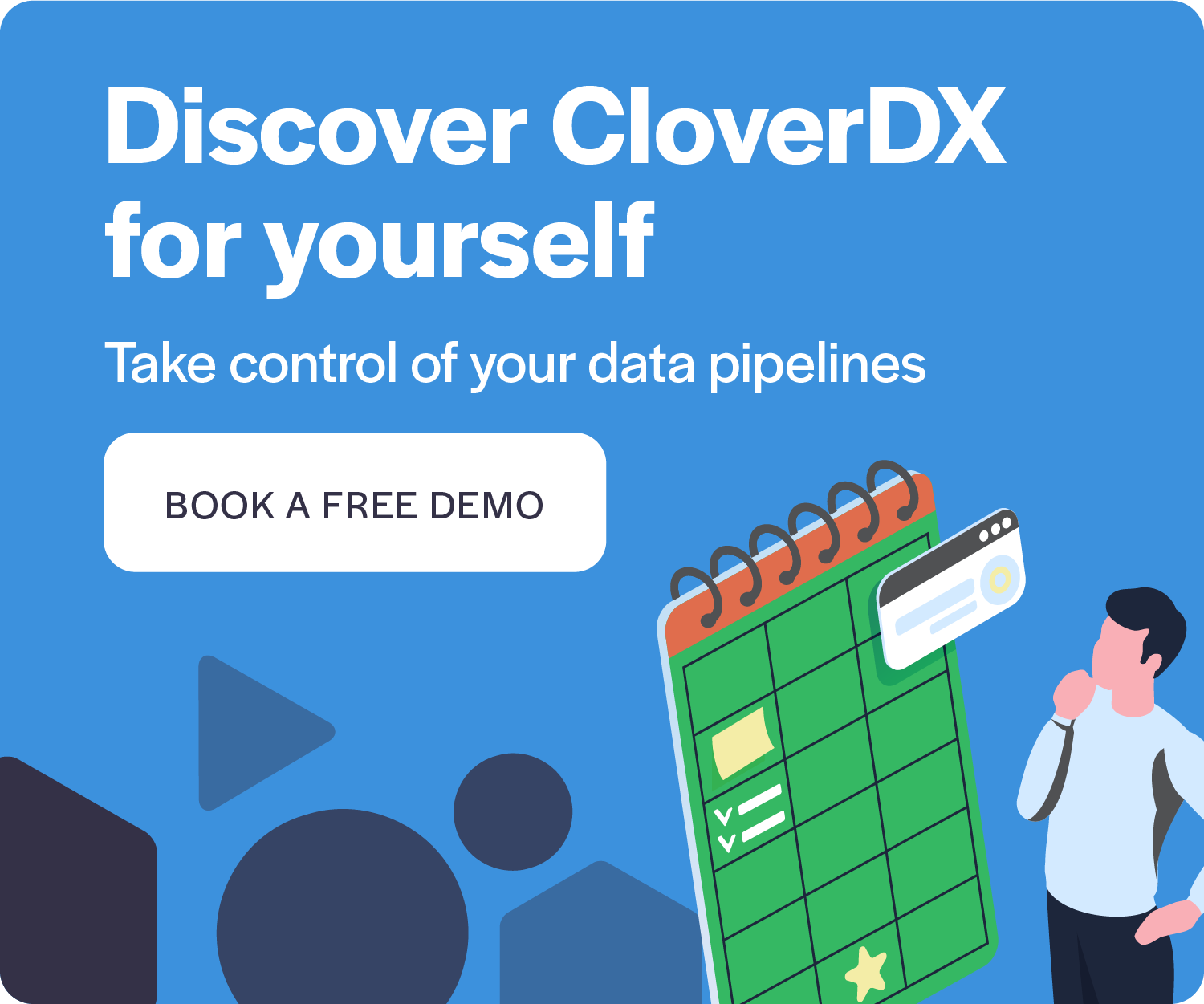Finding your ideal data integration platform can feel daunting. These questions will help you select the right software and - perhaps more importantly - the right partner.
Choosing data integration software can be difficult, especially if your needs are complex.
There’s a wide range of vendors to choose from, and not all will be right for your needs.
We recommend taking a holistic view of the features, pricing, support and technical fit. This article will outline key questions that will take you beyond the initial sales pitch.
The Buyers' Guide to Data Integration Software1. What are you going to use your data integration software for?
Firstly you need to ask - what are you trying to achieve with your data integration software?
Ask yourself: Why does your business need data integration? Is it for a one-off project or an ongoing project? Is your priority data quality, ingesting data from other sources, getting data in and out of a data warehouse, modernising and consolidating your ETL, supporting digital transformation, enterprise data management, or risk management and compliance?
A useful exercise is ‘future retrospection’. Vividly imagine yourself at the end of a successful rollout - what did you achieve? What can you do now that wasn’t possible before? What went well? How did you avoid the pitfalls? Brainstorm this with your colleagues and get their input.
Another helpful requirements-setting exercise is the MoSCoW method. It stands for Must, Should, Could, and Would. It’s a helpful way of sorting essential requirements from potentially distracting nice-to-haves. But it also helps focus your pre-sales analysis on features and functionality in areas that really matter.
Being clear about what a successful data integration deployment looks like for you will help your buying process enormously.
2. Where is your data?
Secondly, where your data sits has a big influence on the software you choose, and the decision will also depend greatly on the number, types, and nature of the data sources you’re looking to connect.
Are you working with a single, giant database or multiple data sources globally, all of which need to be unified? Are you moving data to the cloud from in-house systems? Make sure you ask how this could affect your security, control, and agility over the years. Complex problems don’t need complex solutions; they need elegant solutions.
3. Can your data integration platform solve 100% of the problem?
It’s an old software development rule that the first 90% of a project takes 90% of the time, and the last 10% of the project takes the other 90% of the time. It’s often the same for data integration. You need a tool that solves the whole process, not just the easy bits.
That last 10% might not seem much proportionally, but it can cause more than its fair share of grief if not handled properly. If your data solutions provider has a ‘one-size-fits-all’ product, their platform will likely be limited to a standardized ‘cookie cutter’ approach. Can the solution you’re considering be customized to handle those difficulties?
For example, CloverDX combines code and visual design and integrates with other systems and processes to make it possible to solve the last 10% of the job. Adding the necessary coding to the pipeline and adjusting your parameters makes the difference between solving a problem absolutely and in one place or requiring another third-party tool to hook everything together, which will likely cause trouble further down the line.
Challenges often include
- Dealing with errors and exceptions,
- Reporting,
- Coping with peak workloads,
- Security and privacy
- Troubleshooting
- Maintenance
A data platform needs to work for your entire journey, not just the start. Without the infrastructure to support easier troubleshooting and ongoing adaptability, your platform will be like driving an electric car with a battery approaching zero power: a nerve-wracking and ultimately unsatisfactory experience.
Apply that practical ‘stress test’ to your potential platform. Yes, it may get you going in the right direction. But what happens if a process your company runs each morning suddenly grinds to a halt? Will it need a team of people to help fix the issue? Or will you have the means to troubleshoot as problems arise and make your systems more resilient?

4. What are your future data needs?
Make sure that any data integration platform you evaluate is flexible enough to support existing and future data sources and destinations.
Is there likely to be a change in the volume of data you need to process or the amount of data sources you’re going to need to connect? Are you going to need faster data processing? Planning on building a data warehouse or a data lake? It’s important to make sure you have the ability to be flexible as your business processes and data needs evolve and to make sure your potential solution can scale with your business and support greater complexity if needed.
5. Does this data integration platform increase collaboration between teams?
Consider non-technical users. They might not have the technical capabilities to manage raw data but access to reliable data can be crucial for them to do their jobs. Does the platform have the ability to make accurate, usable data available to those business users, without them needing to rely on IT teams?’
In particular, does the platform have the ability to curate and publish live datasets in a data catalog accessible to non-technical users?
Times have changed. The last 20 to 30 years have seen fewer gatekeepers and bottlenecks in the data landscape. Tasks that once needed specialist developers and technical expertise can now be handled in-house and closer to the end user. This is data democratization in action.
In practice, does that mean much to your business? It should. Data integration can break down some barriers between IT and non-technical users and empower your business through greater collaboration.
Data specialists should be able to manage and curate datasets, while business users can easily access and use the data without needing specialist skills. Beyond freeing up more time, especially for expensive technical specialists, data self-service opens a feedback loop between business users and the technical team, increasing user engagement and educating everybody on best practices.
Ask your prospective provider who in your business will be empowered by their solution. Is the solution focused exclusively on technical users? Or will it benefit everybody?
6. Who’s going to be working with your data integration software?
Who will be working with the software—business teams or IT teams? Who will implement and support it?
Consider how much self-service your organization is willing to take on and evaluate the resources you have available to manage the software in-house.
Who will maintain it, and what will they need access to within the system to keep it running smoothly? Where will they get training, advice, and support?
7. Will you get the support you need to guarantee success?
Data integration is a team effort. You shouldn’t have to do it alone. So the support you get from a data integration platform vendor is a critical success factor. Ask yourself the following questions:
- Is support available 24/7 or only during standard working hours? And it’s not enough to respond to an out-of-hours support request with an automated email. It needs to meaningful support.
- Is support included in the price or is it extra? Similarly, training and consultancy?
- Will you have access to real people and product expertise, or will you be outsourced to a third party?
- Are software upgrades regular, reliable, and consistent?
- Does the vendor have online communities, FAQs and other means of support?
Some of these might not be relevant to your business and, therefore, not worth paying for. Others might be critical. Make sure the provider delivers what you need to suit your requirements.
We’ve found that most CloverDX customers use our support or professional services at some point, whether it’s our specialized courses or professional services. It’s why ongoing support is core to our promise to all customers, for complete peace of mind and the knowledge that no matter what curveballs come your business’s way, we’ll be there to catch them. We’re here to help - we won’t let you fail.
Above all, make sure your provider cares about your successes. Will you be just another account whom they’ll point towards an FAQ or chatbot when you need help, or will they be excited to help solve your complex data problems with human interaction and a friendly manner?
8. What’s your budget?
Realistically, how much are you willing to invest in your data integration software? Acquiring software doesn’t just incur license costs; you’ll need to evaluate the cost of developers or consultants, maintenance and support, as well as product upgrades.
Explore all pricing options and make sure you get a licensing structure that is suited to your business. It might seem attractive to go with a big-name vendor, but it can often be hugely expensive, so you need to make sure the product and service are really what you need.
Equally, you also don’t want to cut corners by going with a vendor that might be cheaper initially but maybe lacks the functionality, reliability or depth of support you actually need.
Future needs are also a consideration – how is your licensing going to scale with your business as it grows? So make sure you do your research and understand different vendors’ offerings – it’s surprisingly easy to be hit with unexpected cost increases, for example with vendors that price by data volumes.
Also, the way you are charged is important. Some vendors follow a SaaS model of charging based on consumption, charging by the number of runs and/or the volume of data processed. This can make it hard to predict how much you will pay, but the costs flex with usage. Others, like CloverDX, charge based on a combination of users and processing capacity, as measured by CPUs in use. See our pricing page for more information about our approach.
9. Have you had a trial and demo with various data integration software vendors?
Download a trial from each shortlisted vendor so you can compare and evaluate their product, service, company and how much of an investment is required in terms of time, cost, manpower and training.
Having a trial and demo of the software is a crucial step in the process of buying a data integration solution and will give you a good indication as to how the product meets your needs. Make sure you ask for a demo that is tailored to your specific use case and not just a generic ‘off the shelf’ demo that shows you only what the vendor wants you to see.
It could also be worth asking if the vendor can show you a demo using your own test data. When it comes to data integration software trials, ask if you are trialing a light version with limited functionality or if you get to see the complete product.
While it’s important to look for features that you need now, you also need to evaluate which features and capabilities might be important in two to five years.
10. How to identify appropriate data integration vendors?
You’ve done all your homework; now how do you find the right vendor? This is again partly down to your individual requirements. Different data integration software vendors have different strengths and will give you different experiences. For example, do you value close business relationships and personalized service? If so, then make sure you choose a vendor that can offer you that. Be realistic about what level of support you’re likely to need both during implementation and on an ongoing basis and make sure your potential vendor’s offering is in line with your expectations. Ask to speak to some of their clients to get a feel for their operations and culture.
11. How will the implementation and ongoing process work?
Implementing data integration initiatives doesn’t always run smoothly, and there will likely be a few hiccups along the way – make sure your vendor can fully validate their processes and turnaround times on critical issues. Ensure your chosen vendor provides adequate support and documentation, including training your team properly. A good supplier will help design your data architecture and provide consultancy services if required. Set clear goals and expectations and establish KPIs so you can measure success for later evaluation.
12. Will the software save my business time and effort?
In the data world, we often hear abstract terms like ‘value’ and ‘efficiency,’ which are well-meaning – and relevant – but fail to convey in clear language exactly what benefits you can expect if you sign on with a given provider.
The key is identifying the pain points and bottlenecks in your internal processes. Are your developers wasting their time on low-level, repetitive tasks when their energies could be more impactful elsewhere? Perhaps stability is an issue, resulting in constant crashes that cost time and energy to fix. Are you struggling to maintain legacy code and ad-hoc integrations?
More and more businesses are adopting automation, recognizing the positive changes it can bring to their workflow. If a data task is repeatable, it can be automated. In doing so, team members can be spared the tedium of having to perform the same jobs – even complex workflows – over and over. When speaking to a prospective provider, ask them plainly: ‘Will your solution allow me to push a button and move on to the next task without worry? Can your platform help reduce the gigantic workload my team currently carries on their shoulders?
Every business will occasionally collect bad data, of course, but an automation solution should let you implement mechanisms that easily handle the vast majority of validations and checks while delivering instant notifications if any problems arise. Over time, your data should require less hands-on attention and become more dynamic and useful as part of the bargain. If the provider can’t promise that, they’re likely not right for you.
Data integration should empower your business and provide solid, measurable improvements. Ask your data provider what those benefits will look like if you choose them as a partner.
Making the right choice
Only you can decide which data integration provider will best suit your business. To some extent, this is a question of culture and philosophy. If they cannot unambiguously and clearly state their answers to the above queries, is that provider ready to get to work and tailor their platform to your use case? If and when problems arise, will they be ready, willing and able to help?
By posing the questions above, you're not just narrowing down the field – you're equipping yourself with all the right information to choose a solution that meets your organization’s needs now and in the future.
Remember, data is only an asset if you’re supported in using it effectively.
Book a personalized demo or get in touch. We would love to answer any questions you may have.










